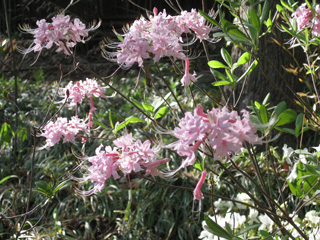Resource Library
Plant of the Week: Azalea, Roseshell Honeysuckle

The roseshell azalea or honeysuckle azalea is the most common wild azalea in Arkansas. (Image courtesy Gerald Klingaman)
Download High Resolution
Plant of the Week
Roseshell Honeysuckle Azalea
Latin: Rhododendron pinophyllum
As a member of the Azalea Society of America I’m fascinated by all azaleas. I became hooked on them upon seeing a mass the old garish Hinodegiri, one of the evergreen Kurume azaleas. Since then I’ve been studying up on azaleas, especially our native deciduous types. The most common native azalea in Arkansas is Rhododendron prinophyllum that goes by such common names as roseshell azalea, wild honeysuckle azalea, mountain azalea or early azalea.
Eighteen species of azaleas are native to North America with 15 of these native to the eastern states. All of our native azaleas are deciduous, along with the evergreen species native to Asia. The roseshell azalea, so named because the flowers have the pinkish-white color of some mother-of-pearl found on the inside of certain seashells, is an open 6 to 10 foot tall shrub. It has deciduous, ovate leaves less than 2 inches long that are hairy on the undersurface.
Flowers appear before or with the expansion of the leaves and are produced in terminal trusses with 10 to 13 individual blossoms. The pink to pinkish-white funnel shaped flowers are about an inch across with a narrow floral tube of equal length. Five slender stamens, twice the length of the floral tube, sweep outward from the face of the flowers. The flowers are very fragrant and clove scented.
Roseshell azalea is the most cold-hardy of our native azaleas and it has an unusual disjunct distribution. It is native to the Ozark and Ouachita Mountains here in middle America but then is absent from the flora until they appear again in the Allegheny range where they extend up to Maine and Quebec. It is absent from the southeastern states where most native deciduous azaleas are found. It typically is found on north facing slopes, along cool mountain streams or even in open pastureland at higher elevations.
This native azalea has been cultivated in Europe since 1812 where it was grown as R. rosea, a name sometimes still associated with the species. It was not separated as a distinct species until 1914 when New York Botanical Garden botanist J. K. Small recognized it as distinct from another superficially similar east coast species.
The use of our native deciduous azaleas in gardens is relatively rare except amongst azalea enthusiasts. Even gardeners who specialize in native plants often shy away from using azaleas because they are seldom available in nurseries, they have relatively exacting requirements and are slow to produce an effective display. Then, once they’ve had their two weeks of bloom, the bush itself is a bit ho-hum in appearance.
Roseshell azaleas are probably the most widely adapted of our native azalea species, being hardy from zone 3 through zone 8. Like all azaleas they require a well-drained, acidic site that is usually best achieved by creating a specific azalea bed. For a single plant I make mine by amending a bag of fine pine bark mulch with a 5-gallon bucket of sand and then blending that mix into the existing soil. This leaves enough extra mix volume to have a raised planting area so that when the rootball is planted it is at least half above the existing soil grade. It is easiest to, instead of creating single planting sites for azaleas, to create entire beds where the soil is amended all at one time.
Roseshell azaleas and most of our other native deciduous azaleas for that matter require more sunlight than most evergreen azaleas. Ideally they should be situated on the east or north side of the house or a bank of trees where they get the light but are shielded from the hottest part of the sun’s glare. Once established they have good drought tolerance but a prolonged summer drought can be deadly or at minimum reduce flower bud set for the following spring.
By: Gerald Klingaman, retired
Extension Horticulturist - Ornamentals
Extension News - May 9, 2014
The University of Arkansas System Division of Agriculture does not maintain lists of retail outlets where these plants can be purchased. Please check your local nursery or other retail outlets to ask about the availability of these plants for your growing area.